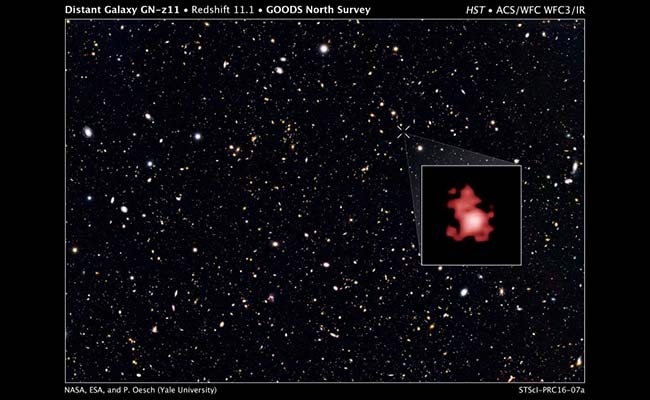-
Tips for becoming a good boxer - November 6, 2020
-
7 expert tips for making your hens night a memorable one - November 6, 2020
-
5 reasons to host your Christmas party on a cruise boat - November 6, 2020
-
What to do when you’re charged with a crime - November 6, 2020
-
Should you get one or multiple dogs? Here’s all you need to know - November 3, 2020
-
A Guide: How to Build Your Very Own Magic Mirror - February 14, 2019
-
Our Top Inspirational Baseball Stars - November 24, 2018
-
Five Tech Tools That Will Help You Turn Your Blog into a Business - November 24, 2018
-
How to Indulge on Vacation without Expanding Your Waist - November 9, 2018
-
5 Strategies for Businesses to Appeal to Today’s Increasingly Mobile-Crazed Customers - November 9, 2018
Hubble team breaks cosmic distance record
If we were back in time and near this galaxy (named GN-z11), we’d see “blue, stunning, really bright young stars” and all around us would be “very messy looking objects” that are galaxies just forming not the large bright spirals we think of as galaxies, said study co-author Garth Illingworth at the University of California Santa Cruz. The galaxy is shown as it existed 13.4 billion years in the past, 400 million years after the big bang and when the universe was 3 percent of its present age. “We managed to look back in time to measure the distance to a galaxy when the Universe was only three percent of its current age”, says Pascal Oesch of Yale University, the paper’s lead author, in a statement.
Advertisement
Using a light light wave signature detected by the Hubble Space Telescope, the astronomers were able to produce a photo of this galaxy that is fuzzy and even deceptive in color.
“So, it’s challenging some of our models, but it’s showing galaxy build-up was well under way early on in the Universe, and it’s a great preview for James Webb, which will be pushing even deeper to see the progenitors of this galaxy”.
GN-z11 is believed to be at least 150 million light years further away than the previous distance record, and reflects a period in the universe when galaxies were only beginning to form. For a long time, competing teams of astronomers were just trying to reach a redshift of 9, about 550 million years after the Big Bang.
The researchers say this record is likely to stand until NASA’s next-generation James Webb Space Telescope comes online. Any distance measurement must take into account exactly how much the space between objects has stretched since an object’s light left and traveled to Earth.
This measurement provides strong evidence that some unusual and unexpectedly bright galaxies found earlier in Hubble images are really at extraordinary distances.
Astronomers measure cosmic distances by determining the redshift of a galaxy.
Prior to today’s disclosure of the discovery, the longest distance observed by Hubble was 8.68 or 13.2 billion years into the past, almost 200 million years newer than GN z-11.
“The discovery of GN-z11 showed us that our knowledge about the early Universe is still very restricted”, said Ivo Labbe, an astronomer at the University of Leiden.
“It’s remarkable that Hubble could do this”, Illingworth said.
Astronomers recalled their feat in a paper published Thursday in the Astrophysical Journal. This high star formation rate makes the remote galaxy bright enough for Hubble to see and to perform detailed observations.
The distant galaxy is 25 times smaller than our own, the Milky Way, and has just 1% as many stars.
[1] The NASA/ESA/CSA James Webb Space Telescope is a collaboration between NASA, the European Space Agency (ESA) and the Canadian Space Agency (CSA).
It is so far away that the light from this extremely faint collection of stars, catalogued as GN-z11, has taken some 13.4 billion years to reach us.
Advertisement
The Webb observatory, a follow-on to the Hubble Space Telescope, is scheduled to fly in 2018. The discovery also has important consequences for NASA’s planned Wide-Field Infrared Survey Telescope (WFIRST), which will have the ability to find thousands of such bright, very distant galaxies.




























